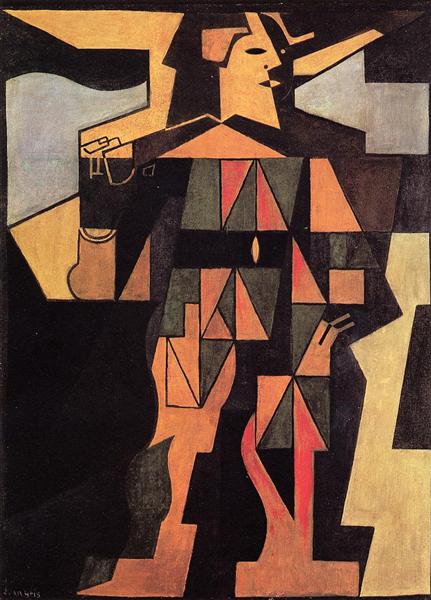Beschrijving
The work "Harlequin" by the Spanish artist Juan Gris, painted in 1915, stands as a monumental example of synthetic cubism, a style that Gris helped to develop and popularize. Throughout his career, Juan Gris distanced himself from traditional avant-garde movements and brought his own interpretation to cubism, focusing on the clarity of form and the study of color. In this painting, the figure of the harlequin, a symbol of comedy and Spanish popular culture, becomes a vehicle for exploring the complexity of perception and representation.
The composition of “Harlequin” is a testament to Gris’ mastery of decomposing and reorganizing the image. The central figure of the harlequin is depicted through geometric fragments in various shades of grey, black and yellow, which combine to give an illusion of volume and dynamism. The duality between figure and background is effectively presented, as if the essence of the harlequin emerges and integrates with its surroundings. This effect is further achieved through the use of superimposed planes that suggest a three-dimensional space, while maintaining the nobility and structure of the two-dimensional canvas.
One of the most striking aspects of the work is its colour palette, where vibrant shades of yellow and blue contrast with darker areas. These contrasts not only provide depth, but also evoke emotions and create a sense of movement within the work. The choice of colours is not merely decorative, but serves to strengthen the visual narrative, suggesting the joy and sadness that often coexist in the life of the harlequin, this figure from the commedia dell'arte who symbolises the duality of the human being.
As for the elements of the work, the representation of the harlequin is not limited to being a simple caricature figure. Gris manages to humanize the character through the complexity of his forms and the subtlety of his expression. The angular shapes and lines that make up his suit, with its characteristic rhombuses, become an extension of his being; they are a manifestation of his dual identity, which transits between art and life. The harlequin's gaze, although abstract and stylized, suggests an emotional connection that invites the viewer to reflect on the paradox of his existence.
"Harlequin" is inserted in a constant dialogue with other works of the Cubist period, both by his contemporary Pablo Picasso and his colleague Georges Braque. However, what distinguishes Juan Gris is his inclination towards clarity and order, in a context where fragmentation and ambiguity predominate. This balance between form and content, between technique and emotion, makes "Harlequin" an essential work in the history of modern art.
Through “Harlequin,” Juan Gris not only reaffirms his own voice as an artist, but also produces a reflection on art itself and its relationship with life. The result is a portrait that, although deeply rooted in cubism, transcends the limits of representation, becoming a meditation on the human condition, art and identity. This work, emblematic of his genius, continues to inspire and captivate those who dare to look beyond the surface, inviting them to explore the multiple facets of being and art.
KUADROS ©, a famous painting on your wall.
Hand-made oil painting reproductions, with the quality of professional artists and the distinctive seal of KUADROS ©.
Painting reproduction service with satisfaction guarantee. If you are not completely satisfied with the replica of your painting, we will refund 100% of your money.

